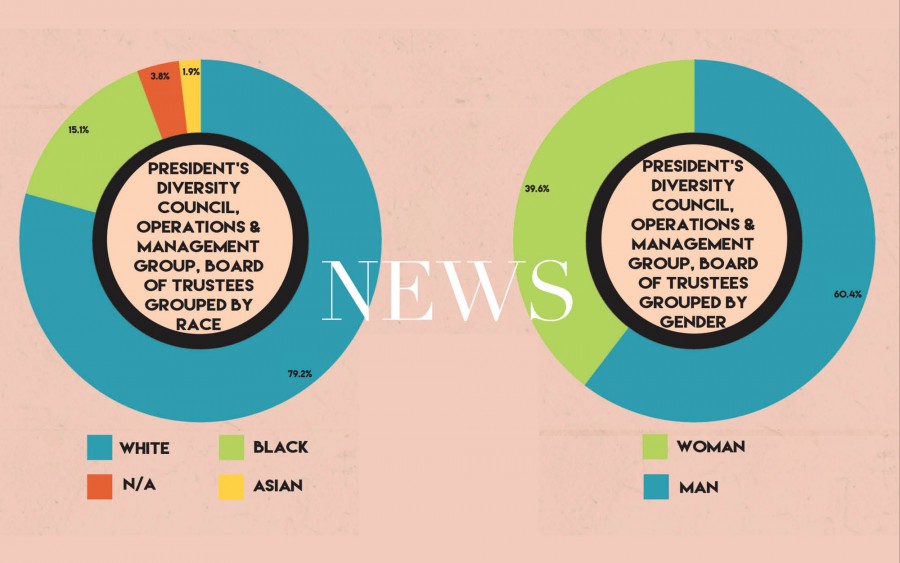Diversity Feature
April 9, 2015
The Bucknell University Five-Year Diversity Plan is a comprehensive plan that focuses on diversity at all academic and social levels in the University community. The plan is an intentional effort to challenge our existing perspectives, and encourages us to broaden our worldviews in hopes of furthering students’ abilities to “make valuable contributions as citizens of a diverse, globally integrated world,” according to the plan.
History of the Diversity Plan:
Plans to address diversity on campus are not new to the University. The 1968 Zeller Integration Plan and the 1985 Black Student Manifesto, along with other assorted campus climate reports, have contributed to the University’s attempt to create a more diverse atmosphere for all faculty, students, and staff. Over time, despite diversity plans, it has become apparent that campus climate has acquired a reputation for “exclusiveness and homogeneity,” the plan writes.
Goal breakdown:
The Diversity Plan seeks to increase diversity in both the faculty and students at the University in a variety of different objectives and strategies. For example, the University is implementing diversity programming with the Office of Admissions staff and tour guides to communicate the plan to prospective students. Additionally, increasing financial aid resources will support the recruitment and subsequent retention of more diverse students.
“The Bucknell Diversity Plan is a living document to help guide our efforts toward increasing diversity on campus and creating a more inclusive, welcoming, and supportive community for all. The faculty resolution passed unanimously at the April Faculty Meeting on April 7 calls on faculty to plan and execute specific actions aimed at improving the campus climate and reducing racism,” Associate Professor of Psychology and Chair of the Faculty Kim Daubman said.
In terms of current University students, the Diversity Plan analyzes current student demographics to support diversity research led by students, staff, and faculty. Similarly, the strategies mandate the collection of data regarding GPA upon graduation, course-taking patterns, and postgraduate career placement.
“The resolution also calls upon the President’s Diversity Council to seek greater engagement and participation from the faculty in executing the evolving diversity plan. To this end, faculty will be meeting next Tuesday, April 14 to identify priorities and to demand action from ourselves and the administration. The faculty have pledged to recommit ourselves with urgency to addressing the presence and manifestations of racism at Bucknell,” Daubman said.
Diversity Goals
1. Improve the diversity of the Bucknell campus community.
2. Develop and maintain a campus climate and culture in which embracing diversity is a core value enacted by all members of the Bucknell community.
3. Enhance students’ diversity-related educational opportunities and experiences to ensure that all students graduate with knowledge, skills, and habits of mind necessary for living and working effectively as members of a diverse, global society.
4. Reflect institutional commitment to diversity by establishing a culture of accountability around diversity initiatives, practices, and policies.
Office of Accessibility’s strategy to address diversity: Barbara
The Office of Accessibility Resources has grown substantially in the past year, most significantly in the office’s name change from “Office of Disability Services.” This change was implemented to “better reflect trends and best practices,” Associate Provost for Diversity Bridget Newell said.
Newell notes that the office has had an “ongoing” evaluation of University accessibility services including an updated website to better reflect service and person-centeredness. More specifically, the office has worked on development for approximately seven new policies developed via practice including: employee accommodation, grievance, test, accommodations, housing/dining, service animal, etc. The office has attained license for text-to-speech reader programs and other assistive technology.
The office continues to be consulted on occasions regarding appropriate signage and messaging on websites, bulletins, and playbills around campus.
Number of OMG, BoT, PDC pages grouped by Race
Number of OMG, BoT, PDC pages with Board of Trustees as Group grouped by Race
Number of OMG, BoT, PDC pages with Operations and Management Group as Group grouped by Race
Number of OMG, BoT, PDC pages with President’s Diversity Council as Group grouped by Race
Number of OMG, BoT, PDC pages with President’s Diversity Council as Group grouped by Gender
Number of OMG, BoT, PDC pages with Operations and Management Group as Group grouped by Gender
Number of OMG, BoT, PDC pages with Board of Trustees as Group grouped by Gender
Number of OMG, BoT, PDC pages grouped by Gender
Number of OMG, BoT, PDC pages grouped by Group





















